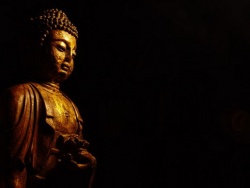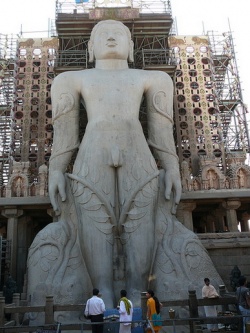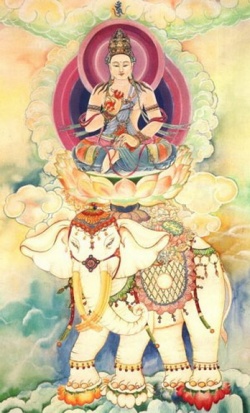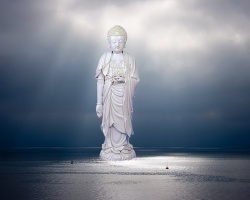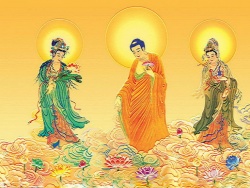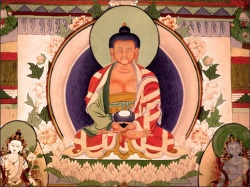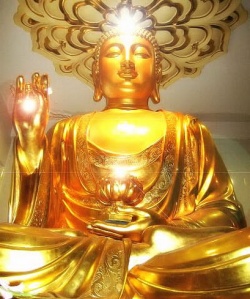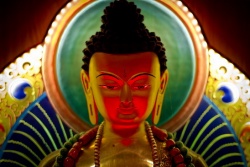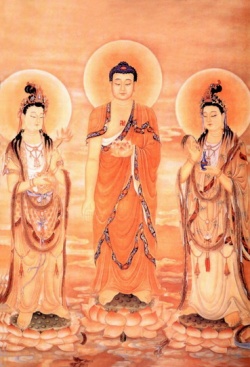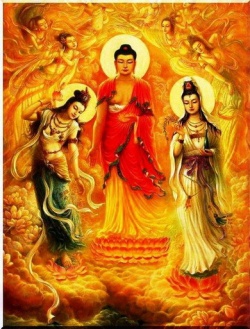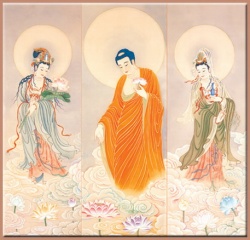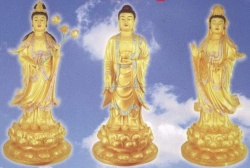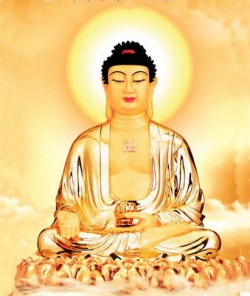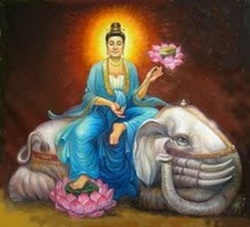Difference between revisions of "The Way of the Yogi"
m (Text replace - "rosary" to "rosary") |
m (Text replace - "thus" to "thus") |
||
| Line 26: | Line 26: | ||
"The [[Secret Mantra]] [[Vajrayana]] of the [[Great Vehicle]] is greatly superior. [[Buddhahood]] cannot be attained in one [[lifetime]] in dependence upon the [lesser] Vehicles, but is attained over many lifetimes, whereas in dependence upon the [[path]] of the [[Mantra]] [[Vehicle]], a [[person]] of superior [[faculties]] can become [[fully enlightened]] in one [[lifetime]] or even in several years. Hence, the [[difference]] in speed in the [[Secret Mantra Vehicle]] is very great."1 | "The [[Secret Mantra]] [[Vajrayana]] of the [[Great Vehicle]] is greatly superior. [[Buddhahood]] cannot be attained in one [[lifetime]] in dependence upon the [lesser] Vehicles, but is attained over many lifetimes, whereas in dependence upon the [[path]] of the [[Mantra]] [[Vehicle]], a [[person]] of superior [[faculties]] can become [[fully enlightened]] in one [[lifetime]] or even in several years. Hence, the [[difference]] in speed in the [[Secret Mantra Vehicle]] is very great."1 | ||
| − | The [[Kagyu]] [[tradition]] is one that refers to itself as a Three [[Vehicle]] (Skt: triyana, Tib: theg-gsum) [[tradition]], because unlike some other [[yogic]] schools, it incorporates all three ways in its training. The ancient [[lineage]] of the [[Kagyu]] [[Order]] began as a yogin-brotherhood, centuries ago in [[India]], amongst tiny groups of white-clad [[Yogis]] and [[Yoginis]] living in [[Uddiyana]], Kangra, [[Nepal]], {{Wiki|Sikkhim}}, Bengal and elsewhere, especially along the edge of the snow-capped [[Himalayan]] range. One of these great [[Yogins]], named [[Tilopa]], collected together four ancient [[esoteric]] transmissions of [[spiritual]] practice, which he taught to his highly learned [[disciple]] [[Naropa]]. These "secrets" of the [[mystical]] [[path]] were passed, in turn, to the [[Tibetan]] [[masters]] [[Marpa]] and [[Milarepa]], and | + | The [[Kagyu]] [[tradition]] is one that refers to itself as a Three [[Vehicle]] (Skt: triyana, Tib: theg-gsum) [[tradition]], because unlike some other [[yogic]] schools, it incorporates all three ways in its training. The ancient [[lineage]] of the [[Kagyu]] [[Order]] began as a yogin-brotherhood, centuries ago in [[India]], amongst tiny groups of white-clad [[Yogis]] and [[Yoginis]] living in [[Uddiyana]], Kangra, [[Nepal]], {{Wiki|Sikkhim}}, Bengal and elsewhere, especially along the edge of the snow-capped [[Himalayan]] range. One of these great [[Yogins]], named [[Tilopa]], collected together four ancient [[esoteric]] transmissions of [[spiritual]] practice, which he taught to his highly learned [[disciple]] [[Naropa]]. These "secrets" of the [[mystical]] [[path]] were passed, in turn, to the [[Tibetan]] [[masters]] [[Marpa]] and [[Milarepa]], and thus have become the tools used today by [[Kagyu]] [[Yoginis]] and [[Yogis]] in their [[effort]] to attain [[Enlightenment]]. |
[[File:S11.jpg|thumb|250px|]] | [[File:S11.jpg|thumb|250px|]] | ||
Specifically the four Oral Injunctions of [[Tilopa]] [[form]] an advanced [[tantric]] course of self-development, pertaining to what is known as Completion-process (rdzogs-rim) [[Yoga]]. This training can only safely be taken up after one has gone through the preliminary exercises (Skt: purvaka, Tib: ngön-dro) and then worked in depth with what is known as Creation-process (bskyed-rim) [[Yoga]]. | Specifically the four Oral Injunctions of [[Tilopa]] [[form]] an advanced [[tantric]] course of self-development, pertaining to what is known as Completion-process (rdzogs-rim) [[Yoga]]. This training can only safely be taken up after one has gone through the preliminary exercises (Skt: purvaka, Tib: ngön-dro) and then worked in depth with what is known as Creation-process (bskyed-rim) [[Yoga]]. | ||
| Line 35: | Line 35: | ||
Initial Steps of the [[Path]] | Initial Steps of the [[Path]] | ||
| − | A whole system of [[spiritual]] exercises have been devised by the [[wise]] [[Kagyu]] {{Wiki|saints}} of the past, to open the [[heart]] to [[sublime]] [[truth]] and | + | A whole system of [[spiritual]] exercises have been devised by the [[wise]] [[Kagyu]] {{Wiki|saints}} of the past, to open the [[heart]] to [[sublime]] [[truth]] and thus fashion it into a perfect vessel for receiving the [[Divine]] Presence (rdo-rje sems-pah). These are known as the Preliminaries, or Initial Exercises (ngön-dro). |
When, in a [[traditional]] Eastern setting, an aspirant wishes to learn the way of [[spiritual]] [[Yoga]], the first step consists of finding a circle of [[Yogis]] or [[Yoginis]], and making application to join them. This involves beseeching the circle's [[Lama]] for initiation (diksa) into the customs ([[carya]]) of the group. The neophyte then is allowed to wear the insignia that distinguishes him or her as a member of the Lama's circle. | When, in a [[traditional]] Eastern setting, an aspirant wishes to learn the way of [[spiritual]] [[Yoga]], the first step consists of finding a circle of [[Yogis]] or [[Yoginis]], and making application to join them. This involves beseeching the circle's [[Lama]] for initiation (diksa) into the customs ([[carya]]) of the group. The neophyte then is allowed to wear the insignia that distinguishes him or her as a member of the Lama's circle. | ||
| Line 49: | Line 49: | ||
(i) The first of the Four [[Meditations]] that turn about the [[heart]] in the seat of [[consciousness]] consists of [[meditating]] for a considerable length of [[time]] on the truly [[precious]] and quite unique opportunity for [[spiritual]] development that is afforded by the [[conditions]] of [[human]] [[life]]. What if one had instead been born a [[dog]] or [[horse]], a [[snake]] or bird, or some other [[form]] of [[sentient being]], would the opportunity to learn about [[Enlightenment]] be present, and would it be possible to be taught a guided [[path]] of [[realization]]? Certainly not. It is only now, in this [[life]] as a [[thinking]] [[human being]], capable of training in [[Enlightenment]], that a [[person]] is afforded a chance to undergo [[transformation]]. We may not find such an opportunity ever again. So the first step consists of [[meditating]] on what it means to be born a [[human being]]. This includes [[meditation]] on the preciousness of [[human]] [[life]]. The [[Lama]] will guide the student in ways of conducting this [[meditation]], day by day. | (i) The first of the Four [[Meditations]] that turn about the [[heart]] in the seat of [[consciousness]] consists of [[meditating]] for a considerable length of [[time]] on the truly [[precious]] and quite unique opportunity for [[spiritual]] development that is afforded by the [[conditions]] of [[human]] [[life]]. What if one had instead been born a [[dog]] or [[horse]], a [[snake]] or bird, or some other [[form]] of [[sentient being]], would the opportunity to learn about [[Enlightenment]] be present, and would it be possible to be taught a guided [[path]] of [[realization]]? Certainly not. It is only now, in this [[life]] as a [[thinking]] [[human being]], capable of training in [[Enlightenment]], that a [[person]] is afforded a chance to undergo [[transformation]]. We may not find such an opportunity ever again. So the first step consists of [[meditating]] on what it means to be born a [[human being]]. This includes [[meditation]] on the preciousness of [[human]] [[life]]. The [[Lama]] will guide the student in ways of conducting this [[meditation]], day by day. | ||
| − | (ii) The second of the Four [[Meditations]] that turn about the [[heart]] in the seat of [[consciousness]] consists of [[meditating]] on the nature of [[Impermanence]] and one's inevitable [[Death]]. This is by no means performed in a casual matter. First the [[impermanence]] of things, of {{Wiki|external}} [[objects]], is observed and [[meditated]] upon. Then [[time]] is spent contemplating one's own [[death]]. What will the [[experience]] be like? How will it [[feel]], as the [[body]] grows weak, the [[mind]] dim, and [[death]] overcomes us? A [[meditation]] like this will reflect not only on different kinds of [[death]], but also on {{Wiki|fear}} about loss of [[self]], loss of [[ego]] and [[existence]] itself. Guided by the {{Wiki|intuition}}, and by the instructions of the [[Lama]], the [[spiritual]] seeker will | + | (ii) The second of the Four [[Meditations]] that turn about the [[heart]] in the seat of [[consciousness]] consists of [[meditating]] on the nature of [[Impermanence]] and one's inevitable [[Death]]. This is by no means performed in a casual matter. First the [[impermanence]] of things, of {{Wiki|external}} [[objects]], is observed and [[meditated]] upon. Then [[time]] is spent contemplating one's own [[death]]. What will the [[experience]] be like? How will it [[feel]], as the [[body]] grows weak, the [[mind]] dim, and [[death]] overcomes us? A [[meditation]] like this will reflect not only on different kinds of [[death]], but also on {{Wiki|fear}} about loss of [[self]], loss of [[ego]] and [[existence]] itself. Guided by the {{Wiki|intuition}}, and by the instructions of the [[Lama]], the [[spiritual]] seeker will thus come to appreciate [[death]] in a way not previously [[realized]]. Since this is taken as a [[meditation]] practice, the profundity of reflecting on [[death]], in this way, will be much deeper than any mere [[intellectual]] or speculative exercise. So the second step consists of contemplating our [[death]]. |
[[File:Url-4.jgfpg.jpg|thumb|250px|]] | [[File:Url-4.jgfpg.jpg|thumb|250px|]] | ||
| − | (iii) The third of the Four [[Meditations]] that turn about the [[heart]] in the seat of [[consciousness]] consists of [[meditating]] on [[Karma]], or in other words, the natural Law of [[Action]]. All [[action]] is [[subject]] to [[cause and effect]]. [[Human]] [[action]] is not separate from natural or [[physical]] law. This means that when an [[action]] is committed, it always produces an effect. [[Evil]] [[actions]] | + | (iii) The third of the Four [[Meditations]] that turn about the [[heart]] in the seat of [[consciousness]] consists of [[meditating]] on [[Karma]], or in other words, the natural Law of [[Action]]. All [[action]] is [[subject]] to [[cause and effect]]. [[Human]] [[action]] is not separate from natural or [[physical]] law. This means that when an [[action]] is committed, it always produces an effect. [[Evil]] [[actions]] thus result in negative consequences. Good [[actions]] result in positive consequences. One feature of this principle is that it removes the [[idea]] that there is any kind of [[Deity]] "out there" who metes out punishment or rewards [[people]] for [[being]] good. We create our own [[karmic]] results by what we do. But [[Karma]] also teaches us that [[causal]] [[action]] is always bound in an [[endless]] cycle. In [[meditating]] on [[Karma]], the seeker is instructed to reflect on the personal way in which [[cause and effect]] has unfolded in his or her own [[life]]. It may also be mentioned here that the private instructions of the [[Lama]] far exceed what is normally and sometimes simplistically taught concerning [[Karma]] in some [[books]]. |
(iv) The fourth of the Four [[Meditations]] that turn about the [[heart]] in the seat of [[consciousness]] consists of [[meditating]] on the inherent [[Suffering]] ([[dukkha]]) of [[living beings]] caught in the [[endless]] cycle of [[worldly existence]] ([[Samsara]]). This [[meditation]], however, is not intended as a morbid practice. It is performed so as to clearly see the nature of [[physical]] [[reality]]. This [[meditation]] also awakens specific [[psychic]] centers within the {{Wiki|individual}}. If we are to "cure" the fundamental [[cause]] of our [[ignorance]], limitation, and conflicted state, we must begin by admitting to the "{{Wiki|disease}}." The {{Wiki|disease}} of [[worldly]] [[life]] is [[Suffering]], Negativity and [[Ignorance]]. Our [[attitude]] can no longer be one of denial, if we truly seek [[Enlightenment]]. Self-transformation is a process that can only begin when the {{Wiki|individual}} admits to the fundamental [[suffering]] of [[self]] and others. | (iv) The fourth of the Four [[Meditations]] that turn about the [[heart]] in the seat of [[consciousness]] consists of [[meditating]] on the inherent [[Suffering]] ([[dukkha]]) of [[living beings]] caught in the [[endless]] cycle of [[worldly existence]] ([[Samsara]]). This [[meditation]], however, is not intended as a morbid practice. It is performed so as to clearly see the nature of [[physical]] [[reality]]. This [[meditation]] also awakens specific [[psychic]] centers within the {{Wiki|individual}}. If we are to "cure" the fundamental [[cause]] of our [[ignorance]], limitation, and conflicted state, we must begin by admitting to the "{{Wiki|disease}}." The {{Wiki|disease}} of [[worldly]] [[life]] is [[Suffering]], Negativity and [[Ignorance]]. Our [[attitude]] can no longer be one of denial, if we truly seek [[Enlightenment]]. Self-transformation is a process that can only begin when the {{Wiki|individual}} admits to the fundamental [[suffering]] of [[self]] and others. | ||
| Line 68: | Line 68: | ||
(ii) [[Vajrasattva]] [[Purification]] Practice: Motivated by a [[sense]] of genuine [[repentance]] for any harm that one may have done in the past, either to oneself or to others — and motivated, we might add, by a wish to be utterly free of any [[feelings]] of [[guilt]] or [[sin]], so inbred into us by our {{Wiki|society}} and {{Wiki|culture}} — the seeker [[contemplates]] a ray of ambrosial white [[light]] coming from [[pure]] [[Vajra]] [[Being]] ("[[Vajra Sattva]]," the [[Divine]] Logos), the [[Buddha]] visualized above the {{Wiki|head}}. This [[light]] descends onto the crown of the {{Wiki|head}}. The way this is done is through [[visualization]] and recitation of [[mantra]]. | (ii) [[Vajrasattva]] [[Purification]] Practice: Motivated by a [[sense]] of genuine [[repentance]] for any harm that one may have done in the past, either to oneself or to others — and motivated, we might add, by a wish to be utterly free of any [[feelings]] of [[guilt]] or [[sin]], so inbred into us by our {{Wiki|society}} and {{Wiki|culture}} — the seeker [[contemplates]] a ray of ambrosial white [[light]] coming from [[pure]] [[Vajra]] [[Being]] ("[[Vajra Sattva]]," the [[Divine]] Logos), the [[Buddha]] visualized above the {{Wiki|head}}. This [[light]] descends onto the crown of the {{Wiki|head}}. The way this is done is through [[visualization]] and recitation of [[mantra]]. | ||
| − | The seeker prays for grace. In [[consequence]] the ambrosial [[light]] is [[imagined]] penetrating into the [[body]], {{Wiki|psychically}} purifying the [[heart]] and transfiguring every cell of the [[body]] into [[spiritual light]]. This is more than a mere [[visualization]]; it is a yearning heartfelt [[prayer]]. The [[duration]] of this exercise is augmented by the steady recitation of a specific [[mantra]]. At the end of each session of practice, the seeker aspires to open [[heart]] and [[mind]], like a [[pure]] and holy vessel, to receive the [[sacred]] presence. The [[Divine]] | + | The seeker prays for grace. In [[consequence]] the ambrosial [[light]] is [[imagined]] penetrating into the [[body]], {{Wiki|psychically}} purifying the [[heart]] and transfiguring every cell of the [[body]] into [[spiritual light]]. This is more than a mere [[visualization]]; it is a yearning heartfelt [[prayer]]. The [[duration]] of this exercise is augmented by the steady recitation of a specific [[mantra]]. At the end of each session of practice, the seeker aspires to open [[heart]] and [[mind]], like a [[pure]] and holy vessel, to receive the [[sacred]] presence. The [[Divine]] thus "descends" into the waiting [[heart]], and takes a seat there, impregnating the [[heart]] with [[love]]. |
In this way, you can see that the [[path]] of [[Buddhist]] [[Yoga]] is actually a process of [[deification]]. The [[human being]] is gradually transfigured into [[Buddha]]. | In this way, you can see that the [[path]] of [[Buddhist]] [[Yoga]] is actually a process of [[deification]]. The [[human being]] is gradually transfigured into [[Buddha]]. | ||
| Line 135: | Line 135: | ||
In Creation-process [[yoga]], the {{Wiki|mystic}} [[perceives]] an [[absolute]] ground ([[alaya]]) as the [[Divine]] Logos (rdo-rje sems-pah, [[Essential]] [[Being]]) [[embodied]] in the [[heart]] of Creation itself. He or she yearns [[to know]], identify with, and ultimately unite with that [[immeasurable]] {{Wiki|mystery}}, which after all, is really the great {{Wiki|mystery}} of [[God]] (lha-nyid, [[Devata]]), as the source of all. | In Creation-process [[yoga]], the {{Wiki|mystic}} [[perceives]] an [[absolute]] ground ([[alaya]]) as the [[Divine]] Logos (rdo-rje sems-pah, [[Essential]] [[Being]]) [[embodied]] in the [[heart]] of Creation itself. He or she yearns [[to know]], identify with, and ultimately unite with that [[immeasurable]] {{Wiki|mystery}}, which after all, is really the great {{Wiki|mystery}} of [[God]] (lha-nyid, [[Devata]]), as the source of all. | ||
[[File:Url-77.jpg|thumb|250px|]] | [[File:Url-77.jpg|thumb|250px|]] | ||
| − | It could be said that the [[aim]] of [[Sadhana]] is [[to know]] [[God]] as a personal relationship (yid-dam gyi [[lha]]) and | + | It could be said that the [[aim]] of [[Sadhana]] is [[to know]] [[God]] as a personal relationship (yid-dam gyi [[lha]]) and thus attain [[mystical]] Union (Skt: [[yuganaddha]], Tib: zung-"jug). This is the same [[aim]] as expressed in all the great [[religions]] on [[earth]]. What we discover is that Creation-process [[meditation]] is a means to gain this [[experience]]. |
Therefore, to accomplish [[mystical]] Union, the seeker learns as follows: | Therefore, to accomplish [[mystical]] Union, the seeker learns as follows: | ||
Revision as of 08:00, 7 September 2013
India is in many ways a land of bewildering contradictions, with one foot still in a very distant age, and the other firmly placed in the modern world. For the tourist and traveler, it seems a land of congested cities, where traffic swirls by in a bewildering procession of blaring trucks, cars, motorcycles and bullock carts. Polluted dust fills the air, streets are crowded with human and animal life; there are stray dogs, cattle, vendors and beggars of every sort, amidst noise and heat, meeting the newcomer as he or she disembarks at New Delhi's airport. And yet, by comparison, the seeker soon becomes enchanted, once that city life has been left behind for the quietness of the countryside.
India is still a vast land of little villages, where farm life is continued much as it always has been, century after century. Here is a land of a hundred dialects, of roadside temples and holy shrines, of grass roofs adorning mud-brick huts: a quiet India spread out before the eye in the form of endless rice fields and Sal forests.
Let us move from the hot plains, up into the cooler hill country of the Himalayas. Here, at Dharamsala or through the Kullu Valley, bordered by towering snow-clad peaks, or further eastward to Rishikesh, or in the valleys of the Kingdom of Nepal, and mountainous Sikkhim, we enter the sacred spaces where for generations male and female Yogins have wandered, seeking peace and insight. Breathing forth a common spiritual fragrance of otherworldliness, love and humble sobriety, these mystics form a continuous stream of saints who have gained a special relationship within the inner soul of Humanity.
Differing greatly from each other in background, character, and way of life—some yogis are Buddhist hermits; others Hindu Shaivites; others of Sikh background; yet others, Moslem mystics and saints; and some, in present times, followers of Christ—they all bear the evident seal of personal sanctification on the heart.
As evening inclines the great ball of the red glowing sun on the dusty western horizon, our eye spans the awesome beauty of the plains below. This is the sub-continent at its very best; at its most serene. It is here that men and women have passed down from ancient times a tradition of profound worth, the very perfection of all traditions recounting the path to self-realization.
The seeker from the West, making his way into the Himalayas, is first drawn to the busy Hindu ashrams and Buddhist monasteries popularly known. Amongst the locals these ashrams and monasteries, where certificates in yoga or lectures on Tibetan Buddhism may be had for a required fee, are referred to as "Tourist Ashrams." Those are the places where we see Westerners congregating in hopes of learning about the spiritual mysteries of the East. But to meet the real Yogis and Yoginis of the Himalayas one has to seek in more remote places. One has to get away from the bustling tourist centres, the popular temples and monasteries where European language is commonplace, and travel to isolated hermitages high in the mountain wilderness.
Genuine Yogis and Yoginis tend to move in small circles, far from the milling crowd. They are self-contained individuals, with no desire to set themselves up as self-important "gurus". We find the true Yogins of the Himalayas, whatever their religion, tradition and customs, ever living private, ascetic lives, far from the busy crowd. Hard to find, even harder for a Westerner to enter their wandering life-style, these hidden mystics are the custodians of yoga traditions that are truly sacred, learned and uplifting. It is in their exclusive circles that individuals can find true wisdom and divine understanding, testifying that in the midst of this troubled world, the ultimate purpose of man's existence is the realization of Enlightenment.
Buddhist Yoga and the Kagyu tradition
Pema Tso Women's Retreat Although different schools certainly have different approaches and techniques, in the Himalayan ranges where lofty Tibetan hermitages cling precariously to the mountain side, or where we find lonely retreat caves occupied by individual ascetics, there is one specific path of endeavor that has been laid out and taught for centuries. This path is the way of the Kagyu school. The Kagyu school teaches a form of spiritual Yoga that is Buddhist in its tradition.
The Buddhist "way of the Yogi" is incorporated in a system known as Vajrayana Buddhism. This is a tradition of Buddhist practice that specifically uses mantra and visualization as a way of augmenting meditation. Vajrayana is viewed as the highest of three distinct "ways" taught in Buddhism. Specifically, these three ways of spiritual development are known as: Hinayana, or the lesser way; the Mahayana, or the greater way; and the Vajrayana, or the diamond way. Another term for the third way is Mantrayana, the way of secret mantra.
A human being is a tripartite entity, consisting of (1) instinctual drives, (2) emotion and (3) discriminative thought – or in other words, body, heart and brain. Observing this, it becomes evident that to transform the human being, thee ways or vehicles (ayana) of spiritual development, three approaches, may be applied. Either, a person can focus work on the root drives, the fundamental psychological forces that make us act the way we do; or on the heart, the emotional centre of man; or on the intellectual centre. The three ways of Buddhism, if we really see what they are devised to accomplish, are therefore systems emphasizing work on one or another of a person's three psychological aspects. The system that mainly focuses on disciplining and training the instinctual drives, is the Hinayana. The system focused on awakening the spiritual heart of man, we know as the Mahayana. And the system that, besides training the instincts and the heart, also incorporates the intellect, is then called the Vajrayana. It is in this sense that the Vajrayana is viewed as the highest of three systems.
His Holiness the Dalai Lama explains:
"The Secret Mantra Vajrayana of the Great Vehicle is greatly superior. Buddhahood cannot be attained in one lifetime in dependence upon the [lesser] Vehicles, but is attained over many lifetimes, whereas in dependence upon the path of the Mantra Vehicle, a person of superior faculties can become fully enlightened in one lifetime or even in several years. Hence, the difference in speed in the Secret Mantra Vehicle is very great."1
The Kagyu tradition is one that refers to itself as a Three Vehicle (Skt: triyana, Tib: theg-gsum) tradition, because unlike some other yogic schools, it incorporates all three ways in its training. The ancient lineage of the Kagyu Order began as a yogin-brotherhood, centuries ago in India, amongst tiny groups of white-clad Yogis and Yoginis living in Uddiyana, Kangra, Nepal, Sikkhim, Bengal and elsewhere, especially along the edge of the snow-capped Himalayan range. One of these great Yogins, named Tilopa, collected together four ancient esoteric transmissions of spiritual practice, which he taught to his highly learned disciple Naropa. These "secrets" of the mystical path were passed, in turn, to the Tibetan masters Marpa and Milarepa, and thus have become the tools used today by Kagyu Yoginis and Yogis in their effort to attain Enlightenment.
Specifically the four Oral Injunctions of Tilopa form an advanced tantric course of self-development, pertaining to what is known as Completion-process (rdzogs-rim) Yoga. This training can only safely be taken up after one has gone through the preliminary exercises (Skt: purvaka, Tib: ngön-dro) and then worked in depth with what is known as Creation-process (bskyed-rim) Yoga.
It is actually from the four instruction lineages of Tilopa that the Kagyu Order derives its name, for "Kagyu" (Tibetan spelling: bka-brgyud) is short for the Tibetan "Theg-pa gsum gyi snying don bka-bab-kyi-chos bzhi gdams-ngag bar ma chad-pai brgyud-pa," meaning: "the unbroken Lineage (brgyud) of the profound and intimate four Oral Injunctions of the Dharma (bka-bab-kyi-chos bzhi), the very essence of the Three Vehicles (theg-pa gsum) of Buddhism."
In what follows we shall attempt to outline, in a brief and extremely generalized manner, how someone practices these unique and very special teachings, and of what the "Way of the Yogi" in our school more or less consists.
Initial Steps of the Path
A whole system of spiritual exercises have been devised by the wise Kagyu saints of the past, to open the heart to sublime truth and thus fashion it into a perfect vessel for receiving the Divine Presence (rdo-rje sems-pah). These are known as the Preliminaries, or Initial Exercises (ngön-dro).
When, in a traditional Eastern setting, an aspirant wishes to learn the way of spiritual Yoga, the first step consists of finding a circle of Yogis or Yoginis, and making application to join them. This involves beseeching the circle's Lama for initiation (diksa) into the customs (carya) of the group. The neophyte then is allowed to wear the insignia that distinguishes him or her as a member of the Lama's circle.
Liberation comes only through recognition of one's true Buddha-nature, a realization gained after much striving, and ultimately dependent on grace (adhisthana). Largely, what the Lama (guru) teaches the student is how to practice the Path and open the heart to this grace. The Preliminaries are really a way of opening the heart.
Exoteric Preliminaries
There are four meditations that "turn around" the heart in the seat of consciousness. In some religions we find people talking about the idea of "conversion," but there the word usually means becoming converted to a religion and a set of beliefs. Here, to turn around or convert the heart in the seat of consciousness, really means to undergo a deep-rooted spiritual change. The result of this change is often called "revulsion," and this means that a certain kind of letting go of our ego-clinging takes place. On the surface this can be experienced as a "revulsion" for purely material and worldly desires. On the other hand, to the same extent that one turns away from seeking protection in the material world, one finds oneself turning toward things of the spirit. A yearning for Enlightenment is born.
When it is said that a "yearning" is born, this does not merely mean a temporary or exotic desire for Enlightenment as some sort of new ego-gratifying fad. If someone performs the four exoteric preliminaries properly, then a genuine conversion of mind occurs, deep within the depths, resulting in a "yearning" for spiritual Release that makes it quite impossible for the seeker to later fall from the Spiritual Path.
(i) The first of the Four Meditations that turn about the heart in the seat of consciousness consists of meditating for a considerable length of time on the truly precious and quite unique opportunity for spiritual development that is afforded by the conditions of human life. What if one had instead been born a dog or horse, a snake or bird, or some other form of sentient being, would the opportunity to learn about Enlightenment be present, and would it be possible to be taught a guided path of realization? Certainly not. It is only now, in this life as a thinking human being, capable of training in Enlightenment, that a person is afforded a chance to undergo transformation. We may not find such an opportunity ever again. So the first step consists of meditating on what it means to be born a human being. This includes meditation on the preciousness of human life. The Lama will guide the student in ways of conducting this meditation, day by day.
(ii) The second of the Four Meditations that turn about the heart in the seat of consciousness consists of meditating on the nature of Impermanence and one's inevitable Death. This is by no means performed in a casual matter. First the impermanence of things, of external objects, is observed and meditated upon. Then time is spent contemplating one's own death. What will the experience be like? How will it feel, as the body grows weak, the mind dim, and death overcomes us? A meditation like this will reflect not only on different kinds of death, but also on fear about loss of self, loss of ego and existence itself. Guided by the intuition, and by the instructions of the Lama, the spiritual seeker will thus come to appreciate death in a way not previously realized. Since this is taken as a meditation practice, the profundity of reflecting on death, in this way, will be much deeper than any mere intellectual or speculative exercise. So the second step consists of contemplating our death.
(iii) The third of the Four Meditations that turn about the heart in the seat of consciousness consists of meditating on Karma, or in other words, the natural Law of Action. All action is subject to cause and effect. Human action is not separate from natural or physical law. This means that when an action is committed, it always produces an effect. Evil actions thus result in negative consequences. Good actions result in positive consequences. One feature of this principle is that it removes the idea that there is any kind of Deity "out there" who metes out punishment or rewards people for being good. We create our own karmic results by what we do. But Karma also teaches us that causal action is always bound in an endless cycle. In meditating on Karma, the seeker is instructed to reflect on the personal way in which cause and effect has unfolded in his or her own life. It may also be mentioned here that the private instructions of the Lama far exceed what is normally and sometimes simplistically taught concerning Karma in some books.
(iv) The fourth of the Four Meditations that turn about the heart in the seat of consciousness consists of meditating on the inherent Suffering (dukkha) of living beings caught in the endless cycle of worldly existence (Samsara). This meditation, however, is not intended as a morbid practice. It is performed so as to clearly see the nature of physical reality. This meditation also awakens specific psychic centers within the individual. If we are to "cure" the fundamental cause of our ignorance, limitation, and conflicted state, we must begin by admitting to the "disease." The disease of worldly life is Suffering, Negativity and Ignorance. Our attitude can no longer be one of denial, if we truly seek Enlightenment. Self-transformation is a process that can only begin when the individual admits to the fundamental suffering of self and others.
The new student is normally instructed to spend something like ten days meditating on each subject—thus, forty days in all. One who takes this Path seriously will find that a spiritual energy is born out of carefully following these exercises in the order that they have been laid out.
Esoteric Preliminaries
(i) Performing Salutation: The first of the inner or esoteric exercises consists of the performance of Salutation (pranam, prostration or making homage). Salutation is a bodily exercise that the Yogi performs while affirming what is called "Going for Refuge" and while generating Enlightened-mind in the heart. We prefer to translate this as "salutation," rather than "prostration," because the latter in the West implies some form of submission or servitude towards a higher authority. Salutation is how you greet someone you love. When, in India, you meet a beloved or respected person, you place the hands together and bow, usually while saying, "Namaste"—I greet you! This is what Pranam or salutation really means.
The performance of salutation is a form of bodily prayer and it is also a hard physical workout. It consists of making one hundred thousand bodily prostrations. However, we find that its ability to create real change in the human psyche is tremendous.
In performing Salutation, to what are our salutations made? In Buddhist tradition, salutation is made to the precious Three Jewels; namely, to the Buddha, the Dharma, and the Sangha. The Buddha is Omniscience itself, absolute knowing intelligence. The Dharma is the teaching, the wisdom. And Sangha means the community. To these three Jewels, again and again, we make salutation.
All these exercises work from the outer to the inner, from the physical to the ever more mental, and then from the mental to the spiritual. The question of transformation must occupy the mind of the seeker constantly, producing great spiritual yearning. Performing salutation does this. It establishes a driving force that prepares the ground for further spiritual struggle.
(ii) Vajrasattva Purification Practice: Motivated by a sense of genuine repentance for any harm that one may have done in the past, either to oneself or to others — and motivated, we might add, by a wish to be utterly free of any feelings of guilt or sin, so inbred into us by our society and culture — the seeker contemplates a ray of ambrosial white light coming from pure Vajra Being ("Vajra Sattva," the Divine Logos), the Buddha visualized above the head. This light descends onto the crown of the head. The way this is done is through visualization and recitation of mantra.
The seeker prays for grace. In consequence the ambrosial light is imagined penetrating into the body, psychically purifying the heart and transfiguring every cell of the body into spiritual light. This is more than a mere visualization; it is a yearning heartfelt prayer. The duration of this exercise is augmented by the steady recitation of a specific mantra. At the end of each session of practice, the seeker aspires to open heart and mind, like a pure and holy vessel, to receive the sacred presence. The Divine thus "descends" into the waiting heart, and takes a seat there, impregnating the heart with love.
In this way, you can see that the path of Buddhist Yoga is actually a process of deification. The human being is gradually transfigured into Buddha.
The Vajrasattva Purification process is one of catharsis, followed by identification. Mantras are used to effect a stage by stage transformation.
(iii) World-mandala Offering: The third exercise of the inner Preliminaries consists of offering up the whole world as a World-Mandala in an act of deep dispassion and renunciation to the Divine. That means, one offers everything. This is an act that grows in meaning as it is performed, and the seeker has to contemplate just what giving up the external play of sense delight may consists of. Gifting is a form of love, and as we yearn to realize Enlightened-mind, our desires are turned into devotion and love. Gifting is also an act of thanksgiving, and as we draw into closer communion with the Divine Reality, so too does our sense of utter gratitude grow and grow.
Offering up the world is a gifting, but it is also a renunciation. In offering the World-Mandala the seeker is partially imitating the great renunciation of the Buddha when he left the world behind, and went forth in search of truth. So, offering the World-Mandala is a gift given out of gratitude, and also a symbolic letting go of our attachments.
(iv) Guru-yoga: The fourth and final esoteric Preliminary exercise is called Guru-yoga, or in Tibetan Lama-naljor, which literally means "Union with the Guru." As most people know, one's personal Lama is what is called the guru. But here, the term "guru" also means something far greater than just the outer or human teacher. The outer guru is the teacher who guides one, the spiritual Master (male or female) to whom one gives devoted allegiance. The inner guru is, however, the wisdom to be found within oneself. The inner guru is one's own innate mind of enlightenment. The secret guru is larger than both the outer and inner – the secret guru is the Buddha-Absolute itself.
The processes of systematic transformation that underlie the Preliminary Exercises have been leading up to this point all along. Through the outer-inner-secret Guru, the seeker is led to the Divine. This is realized in Guru-yoga when the person who is meditating, mystically dissolves into the abstract heart-mind of the spiritual Guru. This is a very sacred moment, brought on by much sighing and heartfelt yearning for the sweet mercy (kripa) of mind-to-mind union.
In the Kagyu system we say that, "the Guru is supreme." He/she is the Buddha, he/she is exemplified in the great saint Guru Padmasambhava, or in the Karmapa, or in Vajrayogini. Our beloved teacher Dilgo Khyentse Rinpoche used to say that in the Preliminary exercises the most extra-ordinary part is this Guru-yoga. It is the practice, he said, by which primordial Gnosis can arise in a person's being.
The great Master Nyoshul Lungtok has said, "In our lineage, through devotion to the Guru, one attains realization. The way of treating a spiritual teacher should not be a matter of mere obedience or respect, but rather one of devotion and love."
The most venerable Kalu Rinpoche, in a somewhat humorous tone, once said, "In the West students are attracted to the idea of obeying a Lama, but the idea of loving the Lama is foreign to them. In Tibet, on the other hand, love and devotion towards the Lama comes easily, while obeying the Lama is foreign."
Again it was Dilgo Khyentse Rinpoche who taught: "Guru-yoga is the way to pray to an authentic Guru and thereby express one's deep, unwavering devotion. It is through this devotion, that one's mind and the Guru's mind become one… Which ever of the different vehicles (or "ways") of Buddhism that one is practicing, it is necessary to rely on the spiritual teacher, receive his (or her) teaching, and practice according to those teachings. There is no other way."
At one time Jigme Gyalwai Nyu-ku (the disciple of Jigme Lingpa) was practicing meditation at Sari. One day he went out of his meditation cave into the sunlight. He was looking over the hills and admiring their stunning beauty, when a fervent recollection of his Lama, Jigme Lingpa, possessed his soul. He was in that very moment completely overcome with love and devotion. So moving was his love, that at that instant he attained complete awakening, and all phenomenal existents came to an end for him. Thus he found himself in the state of pure Mind-in-itself, fully illuminated in the blessed glow of the uncreate Clear Light. This occurred through the grace of Guru-yoga.
The root Lama, who is our own most beloved personal spiritual guru, acts as the instrumental stepping stone, so to speak, to the realization of the Absolute, the secret Guru within us. Our human guru becomes, in Guru-yoga, the most precious means guiding the devotee on the Spiritual Path.
If Guru-yoga is correctly understood and followed, the practice can lead to ultimate freedom. It is important to understand, however, that Guru-yoga is not guru-worship, founded on a cult of personality. We all have heard of certain self-proclaimed false "gurus," bloated on sycophantic adulation, that in recent times have appeared solely with the aim of fleecing their followers—wolves in sheep's clothing. If Guru-yoga is misunderstood, it can be the cause of endless evil. If it is understood correctly, it is one of the main means of self-transformation.
The Master Padmasambhava said, "My secret Tantra Way is very quick, but also very dangerous. It is like a snake caught in a bamboo tube: there are only two opportunities for it to go, either straight up or straight down!" So it is in the case of practices such as Guru-yoga. When it is performed correctly this practice leads to the greatest love and spiritual awakening. If it is performed incorrectly, it can result in merely fostering a harmful cult of personality.
The esoteric Preliminary exercises are what mystical schools such as the Kagyu Order have taught since the beginning of time. However, nothing from without is imposed on the seeker. The student brings transformation about from within.
The Secret Preliminaries
There are a set of exercises known as the secret Preliminaries. These consist of Kor-de Rushan practices and so forth. They are intended as a way of bringing the mind to a state of self-recognition. However, they would hardly be called "secret," would they, if we were to describe them here? So we shall leave further explanation for the Lamas to explain.
The Main Practice of Creation-process Yoga
Receiving Empowerment
Now the yogin is well along on the Spiritual Path, and undoubtedly by the time he or she has completed the above unique training several years have gone by. Through personal experience, he or she has discovered why this amazing path of spiritual exercises is laid out the way that it is. The Yogin realizes that this is truly a stupendous spiritual system, completely unique in the whole world—a system intended to bring the sincere seeker to the gates of Enlightenment in one lifetime.
The Preliminary Exercises, performed according to the endeavor and speed of the devotee, completes the first stage of the Path. When the Yogin has reached a level of catharsis (visuddhi) and has completed the Preliminaries, then Empowerment (according to the tradition of the lineage) is given. Here, we distinguish initiation (diksa) from Empowerment (abhiseka). In initiation the aspirant receives entry into the exclusive and generally small community of Yogins who share together the rites and knowledge concerning yogic processes specific to their own lineage. On the other hand, with Empowerment, which should be conferred only after one has long proven one's worth as a member of the yogic fellowship, the seeker is spiritually "empowered' (saktipat) or "consecrated' (abhiseka) into the divine practice (sadhana) of the circle's unique tradition (sampradaya).
Empowerment means to be blessed through grace. Grace is invisible spiritual power, or Divine presence. Receiving this grace, the grace of the lineage that comes down through all the saints from the Divine Itself, from the Dharmakaya Vajradhara, the heart is awakened. Grace plants a seed in the heart, making it possible for the seeker to practice Sadhana. What this means is that Empowerment makes the heart pregnant with Divinity by implanting in it the seed of sacred love. This Divine-seed is planted in the student. The student does not have to do anything himself. This is the miracle of the Vajrayana system; everything is done by the Lama through the Empowerment, and the seed is planted and the heart becomes pregnant with Divinity. After that, it is only up to the seeker to keep watering the seed with spiritual practice, and in one lifetime the grace that has been planted in the heart can come to fruition.
The Sadhana that the Lama gives to the seeker is a particular format of spiritual practice, intended as a means of personal development and realization. Sadhana is one's spiritual practice. Traditional Sadhanas are ancient methods, tried and tested over thousands of years, which have been introduced by Enlightened Saints as the best and most rapid means for the attainment of Realization.
So, after receiving Empowerment, the devotee commences with spiritual practice (sadhana, sgrub-thabs). This is divisible into two stages: Creation-process (utpatti-krama) yoga, and Completion-process (nispanna-krama) yoga. To be able to properly practice these it is necessary to get the appropriate Oral Transmission (agama), along with one's root Lama's personal Instruction (upadesha).
This is the way that the Himalayan yogis have practiced for centuries. They develop each of these processes through deliberate and systematic meditations.
Practicing Creation-process Yoga
To contemplate and merge in union with the Divine (devata), the Yogi is taught to revert back, by means of meditation, to the dawn of Creation itself: to observe and undergo the very process of the "Big Bang", as the universe explodes outwards from its singular point (bindu) of genesis. The Yogin performs this meditation while conscious of the vast Unified Ground of all Consciousness wherein mind itself is innate to Creation's arena of primordial energy and matter. Thus the meditation leads to a realization that Intelligence (vidya) is spontaneously everywhere, though nowhere localized; that even inanimate matter breathes with potential intelligence — a Consciousness that is evolving in all energy. And since all that we call the Universe is, after all, entirely "energy" (vayu), since even "matter" is really "energy," the whole, therefore, is inherently intelligent, just as it is intelligible.
Guided by the format of the Sadhana that the Lama has given to the disciple to practice, the meditator gains an experience of unification with the whole. The meditator recognizes that consciousness and appearance, observer and observed, are two aspects of a single cosmic event.
There are many insights that derive from Sadhana practice. Some of these insights might be expressed as follows:
A sentient being's conception in the womb may be viewed as a symmetry-collapse of an abstract wave function of All-Ground Consciousness (as a non-local field) to a local and individualized psychic monad, correlated with the responsive organic cerebral/nervous system and body as determined by genetic inheritance.
It is the temporal continuum of a repetition of just such "collapses" of abstract All-Ground Consciousness (kun-gshi nam-par shes-pa) that is perceived as a series of reincarnations. When this is actually experienced by the mystic, it becomes apparent that, ultimately, death does not exist. We live many lives, like a series of beads on a rosary, but the greater reality is the Continuum (santana) itself — the string that holds all the beads together.
The ocean of Being-Consciousness-Energy (sat-chit-ananda) that is the Universe, has its source in a higher Reality (dharmata), towards which the meditator is ever yearning. This is that most intrinsic Intelligence (vidya) called Buddha, the innate non-dual totality behind all that exists.
In Creation-process yoga, the mystic perceives an absolute ground (alaya) as the Divine Logos (rdo-rje sems-pah, Essential Being) embodied in the heart of Creation itself. He or she yearns to know, identify with, and ultimately unite with that immeasurable mystery, which after all, is really the great mystery of God (lha-nyid, Devata), as the source of all.
It could be said that the aim of Sadhana is to know God as a personal relationship (yid-dam gyi lha) and thus attain mystical Union (Skt: yuganaddha, Tib: zung-"jug). This is the same aim as expressed in all the great religions on earth. What we discover is that Creation-process meditation is a means to gain this experience.
Therefore, to accomplish mystical Union, the seeker learns as follows:
(1) A particular bodily posture must be maintained, and then repetitive invocatory prayer, or "mantra of the heart" (hridaya-mantram), is recited. The use of mantra is in fact the fundamental essence of Vajrayana; the single method which supersedes all other techniques of meditation.
Here mantra is understood to be a short invocation, either addressed to the Divine Nature (Vajra-dhara) directly or to a Bodhisattva or one of the holy Saints, generally composed in Sanskrit and charged with spiritual energy. The power of a mantra lies in the fact that it was composed by realized Saints, who were possessed of an acute insight into the power of sound and prayer. The hearts of the Wisdom-Masters of old were overflowing with love for the Divine, and when they composed our mantras, they imbued them with that devotion and with their wisdom. It is their love and wisdom that gives these invocatory ejaculations such spiritual effectiveness.
(2) The mystic is taught to slow down the rhythm of the breathing, so that it gradually becomes regulated in harmony with the rhythm of the invocatory recitation (japa). He or she must acquire, through practice, the secret technique of relating the recitation of mantra with the cycle of the heart.
(3) As she or he modifies the breath, the yogin is next taught to search inwardly for communion with the Divine in the "secret place" of the heart. Thus the consciousness is made to descend into the very core of the heart, into what is sometimes called the "secret cave" of the soul, so that the intellect (yid) and the psyche (sems) may join in harmonious integration. If he (or she) keeps this up, after some time of deep habituation, there arises a most special type of joy and peace, which is a sign that the mystic is connecting to the depth of the psyche. Once established in the depth of the psyche, the consciousness (nam-shes) begins to behold itself entirely luminous and without boundaries.
(4) Perpetual recitation of "Mantra of the Heart," and the gradual exclusion (dben) of the mind in undistracted "remembrance of Divinity" (lha-nyid dran-pa), transports the yogin, through love and ecstasy, to the supreme reality experienced as the uncreate Clear Light ('od-gsal), where "ego" dissolves completely into the vast ineffable emptiness of the God-head (lha'i-lha-nyid).
The aim here is for the individual to be transfigured in entirety through unsurpassable grace, clarity and great bliss. Then it is said that the finite person's "self-reality" (bdag gi de-ko-na-nyid) and the "Divine-reality" (lha'i de-ko-na-nyid) become "of one taste" (ro-chig) in the wholeness of indivisible mystical union (zung-'jug).
There is great significance in the fact that the Tantric path begins with a heart centred practice first. Work on the heart must precede Completion-process yoga, which focuses on channeling and raising the forces of the lower cakras. The heart-cakra is the "sun' of our internal planetary system of psychic-centres. The heart-cakra is the "leader,' and it leads or commands the other cakras. So the heart cakra must be developed first, then the others will obediently follow in due order. This is the "safe' way of proceeding on the Tantric path.
It must be made clear that the yogin views the relationship with the Divine as something really very different from what people ordinarily imagine it to be. It is natural for human beings to look upon what they call "God" as a "cosmic being" separate and distinct from themselves — someone or something "out there," somewhere in the heavens above. In such a relationship man and God appear as a duality — as separate, and as two entities. But the mystic appreciates, or must learn, that this is not necessarily so at all. In Buddhism the concept of Buddha is not that of an "entity" separate from oneself. The Absolute cannot be objectified, and any attempt to do so merely transforms the Divine into a sort of idol. The yogin's relationship to the Absolute is quite different from the dualistic (and therefore simplistic) conception that many people have of God as a "Creator" and of themselves as a created "creature", or of external "deities" and a separate "self" that worships.
The true Yogin neither worships gods nor idols, nor relies on any entity external to himself/herself, but rather, looks within to seek the authentic Reality at the very core or source of beingness itself. This understanding implies a letting go, beyond words, even beyond thought; an emptying of oneself into pure Unity, a oneness that is endless, transcendent and awesome. To experience this, is to know the inconceivable mystery of Absolute Emptiness, which for lack of better words is absolute Godhead, totally complete in Love and Wisdom. Non-duality alone defines the yogic experience of Buddha, and it cannot be otherwise.
As stated by Lama Thinley Norbu Rinpoche:
"According to the Vajrayana, union is the main practice to attain Enlightenment. The ultimate union is becoming the same as Buddha. In Buddhism, union is not substantial, but indivisible as in the union of impalpable appearances and the wisdom of great emptiness. Enlightenment is the state of indivisible union. Buddhists believe that not only man but all sentient beings have the potential to become one with Buddha."
In another passage, Rinpoche further states:
"For Buddhists, there is no division in the sphere of the Absolute. From the Buddhist point of view, whatever the essence of God is called, it is supposed to be inexpressible, inconceivable, non-substantial Gnosis. Until attaining the state of union, one prays, worships, does good deeds, and meditates. But is God always supposed to be left separately and a person left separately praying? ...if one changes and gets closer to God, then the one who is praying can become the same as God. That is infallible union. This means, according to Buddhist tradition, there is no 'I' and there is no 'Thou'." 2
The Practice of Completion-process yoga
The Completion-process yoga of the Kagyu originally derived, as said above, from the oral transmission of the two Yogi-saints, Tilopa (the bKa-bab-bzhi, or Four Oral Injunctions) and Naropa (Naro Chös-drug, the Six Doctrines of Naropa). Combined with this is the priceless Mahamudra teachings that have come to us not only from Tilopa, but also from Saraha, one of the most renowned of all the Kagyu saints. We believe these to be the most profound set of spiritual "practice-teachings' known to mankind. Their unique custodian on earth is His Holiness the Gyalwa Karmapa.
When the seeker has been practicing the path with real commitment for some considerable time, absorption in the Divine, brought about by one-pointed concentration and repetition of mantra, causes the energies of the body to be gathered in the central nervous system (avadhuta-nadi). This starts a process where the mystic is gradually absorbed into blissful Samadhi. There are a number of internal experiences associated with the onset of this exceptional state. Ecstasy is a very natural and inherent part of what is experienced.
Samadhi is an altered state of expanded consciousness; a vivid awakening of consciousness accompanied by ecstatic feelings, luminosity and mystical trance. As the meditator is inwardly drawn into Samadhi, there begins what is then called the Completion-process.
The Completion-process yoga evolves out of the practice of the Creation-process. It is not as if, having finished the earlier practices described above, now the yogin must start on a whole new set of exercises, which are distinct from what he or she has been doing. Quite the contrary! Just as the basic preliminary exercises naturally lead into Creation-process yoga, so too does the latter naturally unfold into Completion-process yoga.
Six stages of absorption occur, which have been described as exclusion of Being (lus-dben), Word (ngags-dben), Mind (sems-dben), dawning of the uncreate Clear Light ('öd-gsal), final crystallization of the Illusory-body (sgyu-lus), and then, Mystical Union (zung-'jug). However, to guide this process, Tilopa and the other great Masters of the past, delineated the individual stages of this spiritual evolution and gave to each stage specific guidelines. Tilopa's guidelines, the Four Oral Injunctions, may be briefly outlined as follows. Please understand that no attempt is being made here to describe "how" these instructions are initiated or practiced. This is merely an outline, a sort of overview.
1. gTum-mo, the ascension of Psychic-energy through the central nervous system: This is the essence of Tilopa's instruction, in which the nerves (rtsa), nerve-plexus cakras (khor-lo), and motility or nervous energy (rlung) of the psychic-body are applied as a means to ignite and raise the fierce energy of Kundalini (Tib: gTum-mo, Skt: Candali), in what is experienced as a blazing rush of ecstatic force and conscious expansion. By guiding the process, deliberately, the Yogin is rapidly absorbed in Samadhi and experiences oceanic Consciousness, the universal field of sentience in which all beings live and die.
According to the teachings of the Kagyu Lamas, the aim of gTum-mo practice is to actualize mystical union in the non-dual Gnosis of great bliss and emptiness on the path of transcendental Enlightenment. To practice gTum-mo, the Yogin initially has to be celibate. Later, this is not necessary.
As said by His Holiness the Dalai Lama:
"Through becoming skilled in the techniques of putting concentrative emphasis on internal energies (rlung, prana), channels (rtsa, nadi), essential constituents (khams, dhatu), and so forth, the mind enters into the sphere of the Great Seal (physag-rgya chen-po, mahamudra) of Clear Light devoid of dualistic elaborations. Through being absorbed in this yoga, the resultant Wisdom Truth Body of a Buddha is achieved." 3
2. sGyu Lus, the Psychic-body practice: The special methodology of psychic-body (mano-maya-deha, mind-made-body) practice concerns the development of an interior vehicle of consciousness fashioned out of the vital psychic energy of the physical body.
Many people who have studied occult or theosophical theories believe that within human beings there exists a mental body or phantom body (sometimes called the astral body), distinct from the physical body, and they imagine that this body naturally exists in a developed form. They believe that during sleep, or when someone dies, this so called body of light is projected from the physical, and carries the soul through the after-death (bardo) state on its journey to a new life. This is only partially true.
Actually, the psychic body in man exists only in a rudimentary, undeveloped condition. Special mystical exercises are needed to harmonically crystallize the psychic-substance of this body, so that it can exist independent of the physical organism. If these exercises are not performed, then after the death of the physical body, the psychic body begins to lose energy and dissipate, which means that the least it can survive is roughly forty-nine days, or less.
The key of spiritual advancement to a higher stage in the evolutionary cycle lies in the independent crystallization of the manomaya-body. As rightly said by our respected friend Jose Arguelles:
"Through the circuitry of the light body we can directly hook up to the solar power house. The electromagnetic pulsations picked up by our sensory system, channeled by our neural canals, refined through our chakra system... are one and the same with the pulsations of the solar body, the Sun, our local star... Even more, it is through remaining in resonance, that the solar-psychic frequency... is maintained; that the light body is nourished; and that we may discover the knowledge and energy necessary for our own individual maintenance." 4
3. Od-gSal, the realization of uncreate Clear Light: This practice is the essence of the path of Mystical Union. The practitioner merges with the heart until he achieves the samadhi of the Uncreate Light, at which point all of experience becomes a spontaneously natural state of immaculate clarity and absoluteness. The Clear Light is the sublime effulgence of the Divine, the very presence of the Absolute (buddha) shining in the secret cave of the Yogin's heart. The vision of Clear Light is the "culmination' of gTum-mo practice. It is the Unitive Vision.
Furthermore, it is at the time of the actual dawning of Clear Light that the interior psychic-body (mano-maya-deha) separates and ultimately becomes uniquely crystallized. It may then be re-blended with the physical body, resulting in a corporeal transfiguration. This process of transfiguration has been described as a prismatic 'rainbow-body' of super-refined resonance. With the advent of Clear Light, the whole comes to be reflected in each and every atom, in every grain of sand and every mote of light.
As stated by Tsele Natsok Rangdrol: "When ordinary thought processes dissolve into the primordial expanse of Clear Light... You will perceive countless displays of Buddhafields in each pore of your body... on each blade of grass, in each leaf on a tree, and on every speck of dust." 5
4. Las-kyi phyag-rgya, Karmamudra: As stated by His Holiness the XIVth Dalai Lama: "In order to [finally complete the] development of gTum-mo, under certain circumstances and conditions, one should rely on a female consort as one's partner, and this is the meaning of Dakini."6
This is the teaching that acknowledges our human love and sexuality as a love that may be sublimated into perfect Divine Love, capable of inspiring the very highest realization. It is by such love—the melding together of two souls as one—that the final knots (mdud) of the heart may be released, transforming the Saint's initial vision of Clear Light into unsurpassed Union. Since Karmamudra practice is impossible to achieve prior to the culmination of the path of gTum-mo, its method is not taught until the seeker has first attained success in those yogas.
Conclusion
The art of meditation is central to Buddhist spirituality. Our teachings furnish the principles that outline and explain this art in its most perfect form. Through meditation, women and men may learn to transform their personality, realize the true nature of the mind, awaken innate psychic faculties and even manifest miraculous powers. Thus with time, they come to Great Enlightenment, and know the mystery of Buddha.
Footnotes
1 The Dalai Lamag the Eye of New Awareness, Wisdom Publications, London 1985).
2 Thinley Norbu, Welcoming Flowers, Jewel Publishing House, NY 1997. Note how closely the final line in Rinpoche's statement corresponds to the words of the Christian mystic Meister Eckhart: "When I go back to the divine ground, back to the Godhead, there is no one to ask where I have been, and God passes away."
3 Dalai Lamag the Eye of New Awareness, Wisdom Publications, London 1985)
4 J. Arguelles, The Mayan Factor: Path beyond Technology, Bear & Co., New Mexico 1996.
5 Tsele Natsok Rangdrol, Circle of the Sun, Kathmandu 1990.
6 Quoted by Judith Simmer-Brown in Dakini's Warm Breath, Shambala 2001. His Holiness here uses the phrase "female consort," but the consort would be a "male consort" from a woman's perspective. The sex of the consort is not the issue here.
